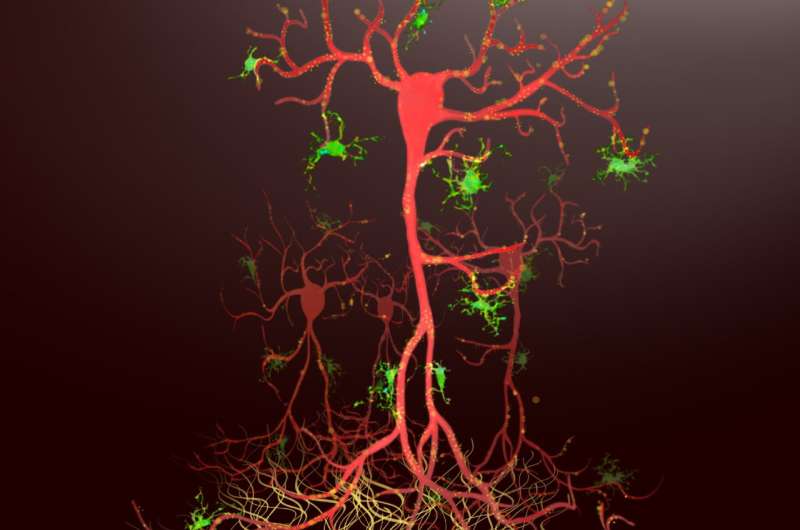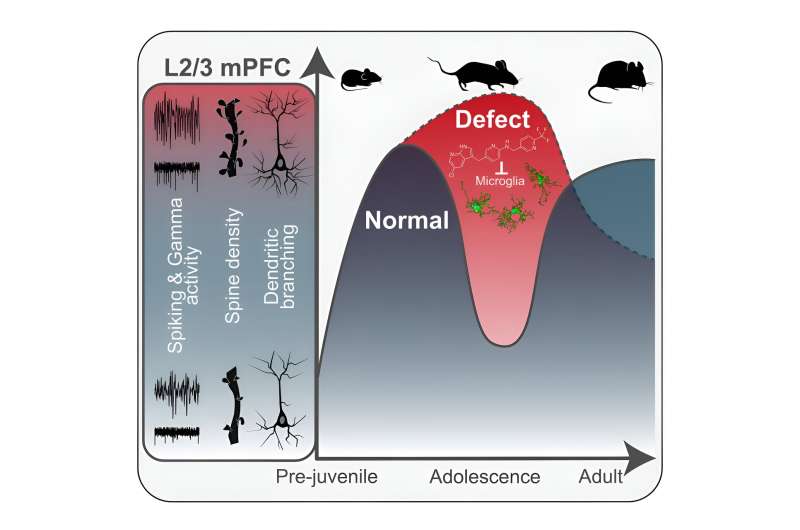March 20, 2024 feature
This article has been reviewed according to Science X's editorial process and policies. Editors have highlighted the following attributes while ensuring the content's credibility:
fact-checked
peer-reviewed publication
trusted source
proofread
Reorganization of prefrontal cortex circuitry during adolescence enables cognitive maturation of mice

Neuroscientists have been trying for decades to understand how the brains of humans and other animals develop throughout the lifespan. While their work has gathered much insight into brain maturation and development, many questions remain unanswered.
Adolescence, the period from the onset of puberty to early adulthood, is known to be marked by significant changes in the prefrontal cortex and other brain circuits. These changes have been linked to the development of new mental abilities and cognitive skills.
Researchers at University Medical Center of Hamburg-Eppendorf recently carried out a study on mice aimed at further exploring changes that occur in the prefrontal cortex during adolescence. Their paper, published in Neuron, outlines patterns in the re-organization of this crucial brain region associated with the regulation of executive functions (i.e., planning, decision-making, the modulation of social behavior, etc.).
"A couple of years ago when we started to perform head-fixed chronic recordings in developing mice for another project, we recognized that activity within layer 2/3 of the medial prefrontal cortex changes not linearly with age during adolescence," Dr. Jastyn A. Pöpplau and Prof. Dr. Ileana L. Hanganu-Opatz, co-authors of the paper, told Medical Xpress.
"This observation was very unexpected and led to the development of a new project with the primary objective to explore the patterns of electrophysiological activity in layer 2/3 of the medial prefrontal cortex along adolescent development."
As part of their recent study, Pöpplau, Hanganu-Opatz and their collaborators compiled a large dataset containing recordings collected in both still (but not anesthetized) immobilized and freely moving mice. These recordings specifically monitored the activity of neurons within layer 2/3 of the medial prefrontal cortex.
The researchers investigated mice at different points in their lifespan, ranging from pre-puberty to adolescence and adulthood. Their analyses explored the patterns of neuronal and network activity in the medial prefrontal cortex at different stages of development, as well as the locomotor activity and behaviors of the mice.

"We were able to show that adolescence is characterized by a peak of gamma and spiking activity which relates to morphological changes (i.e., peak of dendritic complexity and spine density of layer 2/3 pyramidal neurons) during adolescence," Dr. Pöpplau explained. "Notably, similar structural changes have been identified in humans during comparable time windows."
As part of their analyses, Pöpplau, Hanganu-Opatz and their colleagues also set out to explore the neural processes mediating the establishment, breaking and re-organization of prefrontal circuits during development.
Their findings suggest that the timeline of functional and structural fluctuations during adolescence is linked to an increase in the phagocytic activity of microglia cells (i.e., immune cells of the brain). Phagocytosis or phagocytic activity is the process through which immune cells surround and ingest dead cells, foreign materials, pathogens, and other particles.
"As proof of principle, we ablated microglia cells from the brain," Pöpplau said. "We found that microglia ablation during adolescence, but not during pre-juvenile or adult age, resulted in a long-lasting disruption of adult network function and cognitive abilities, mirrored by decreased decision making and working memory abilities in manipulated mice."
Overall, the findings of this recent study confirm that adolescence is a crucial period for the development of prefrontal cortex functions and related cognitive abilities. It particularly unveils changes that unfold in the middle of mice puberty around puberty in the 2/3 layer of the mouse medial prefrontal cortex.
"To our surprise, we found that these non-linear changes during adolescence were mainly present for regular spiking neurons (i.e., putative layer 2/3 pyramidal neurons) but not for fast spiking neurons (i.e., putative parvalbumin expressing interneurons)," Pöpplau said. "To confirm this observation, we optogenetically manipulated interneurons and found that interneuronal development rather follows linear changes with age."
The researchers ran further analyses to validate their findings. Their results suggest that the reorganization of prefrontal circuitry during adolescence could be primarily mediated by a type of cells known as pyramidal neurons.
"Future projects will explore the role of different neurotransmitters and hormonal changes during adolescence for distinct neuronal subpopulations and age-dependent changes of cognitive performance," Pöpplau and Hanganu-Opatz added.
More information: Jastyn A. Pöpplau et al, Reorganization of adolescent prefrontal cortex circuitry is required for mouse cognitive maturation, Neuron (2023). DOI: 10.1016/j.neuron.2023.10.024
© 2024 Science X Network


















